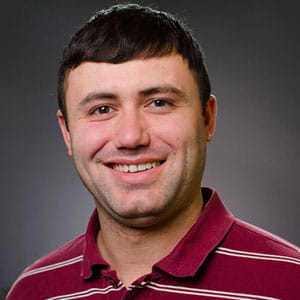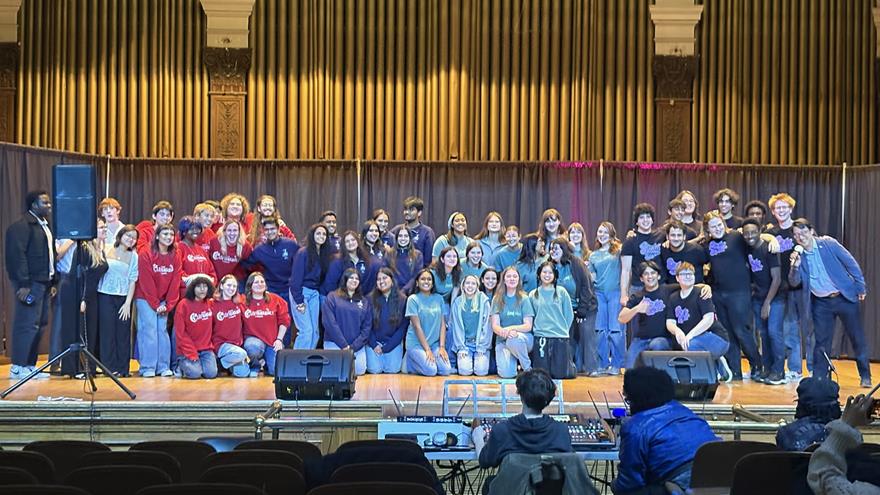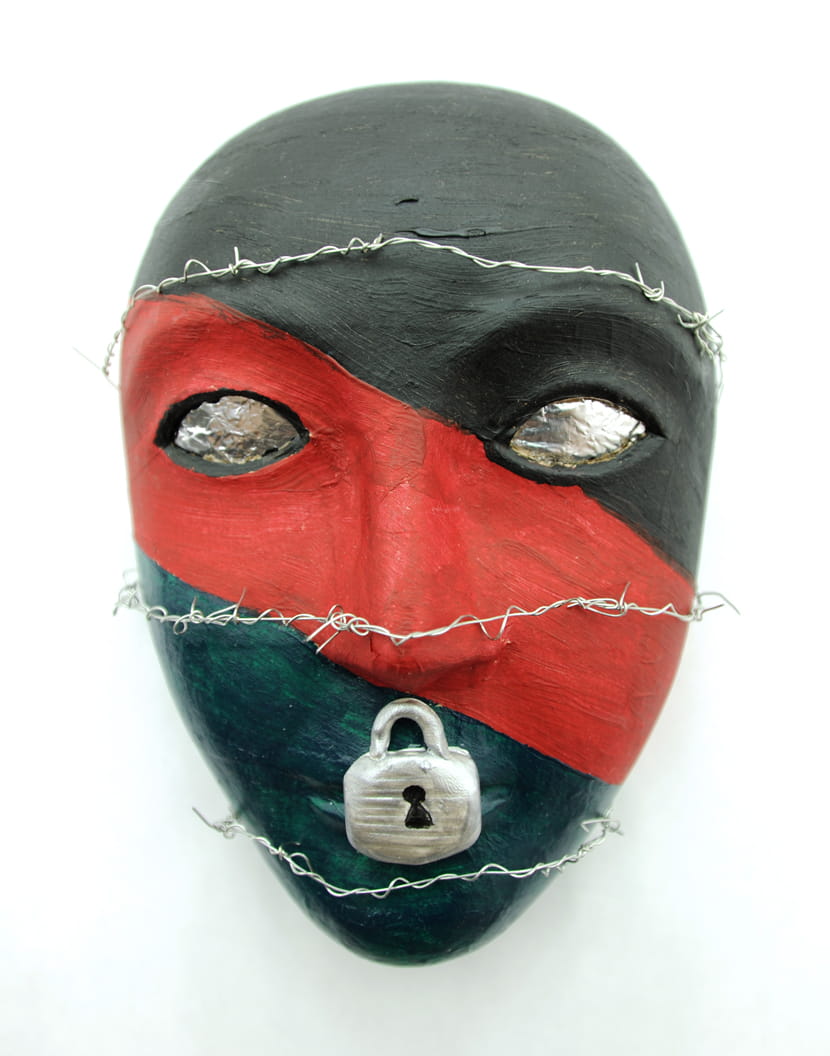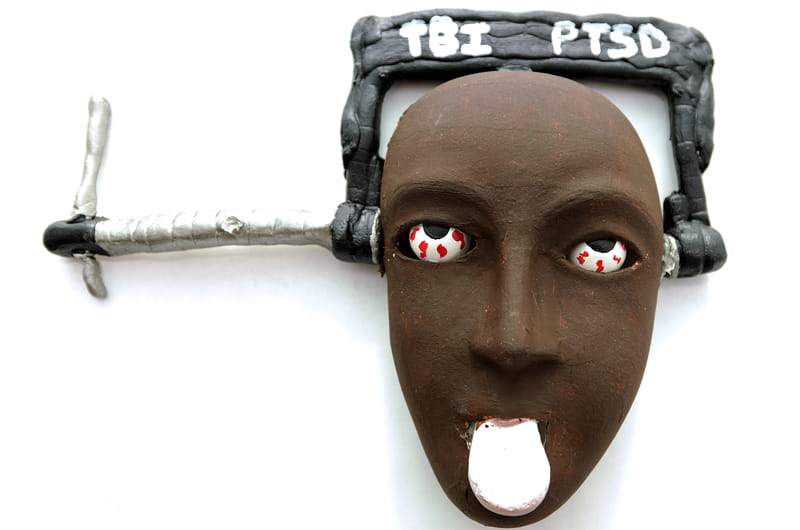Putting a Face on Recovery: Analyzing Military Service Members’ Masks
 By Frank Otto
By Frank Otto

- Drexel-Penn A Cappella Sing-Off Brings a New Battle of 33rd Street
- How and When Could AI Be Used in Emergency Medicine?
- Drexel Public Health Researchers Lead $3.7 Million Study Looking at Impact of Federal Housing Assistance on Health Care for Chronic Conditions
- Drexel Co-ops Learn the Art of Conservation and Collections Care

In military circles, the feeling of community is important and a strength soldiers, sailors, Marines and airmen can draw upon.
Girija Kaimal, EdD, an art therapist and assistant professor in the PhD program of the Department of Creative Arts Therapies in Drexel's College of Nursing and Health Professions, has noticed that the military sense of community carries over into recovery.
Since the end of the summer, Kaimal has been working on a collaborative research study on paper-mâché masks created by active duty service members who have returned from the wars in Afghanistan and Iraq. The masks are part of an art therapy program for service members who’ve suffered traumatic brain injuries and post-traumatic stress disordered.
Run by Melissa Walker, an art therapist and healing arts coordinator with the National Intrepid Center of Excellence (NICoE) at Walter Reed National Military Medical Center, the program encourages service members to make multiple pieces of art. The masks, which represent their feelings about their experiences and identity in the military, are designed upon entry into the four-week integrative treatment program.
“For some service members in the program, the masks become a ‘visual community,’” Kaimal said. “They see the masks and say, ‘I’m not alone.’”
Drexel’s College of Nursing and Health Professions has partnered with the program to analyze the artwork and narrative descriptions on what the artwork represents to the service members — starting with the masks — so that future therapy efforts can be better informed of the unseen inner lives of service members with post-traumatic stress disorder and traumatic brain injuries.
They’re also studying how the themes in the masks relate to other clinical symptoms to see if the visual representations relate to any recurring demographic or clinical features.
Participants in the study paint, add clay or cut the masks’ paper-mâché base to visually represent feelings about their military service.
“What this gives us is a chance to understand the military experience from the service member’s perspective,” Kaimal said.
Walker runs the clinical end of the program, working with the soldiers, sailors, Marines and airmen at the hospital. But she approached Drexel to collaborate on analyzing the masks for common themes in 2013. This summer, the funding was secured through the National Endowment for the Arts (NEA) through the NEA Military Healing Arts partnership and the study commenced.

Since the program began, close to 1,000 masks have been created. Four hundred of those are being analyzed by Kaimal. She’s been assisted by Adele Gonzaga, a research coordinator, and graduate students Kate Myers-Coffman and Bronwen Landless.
Analysis shows the masks cover a range of emotions and perspectives that represent both sources of strength and the struggles of living with PTSD, traumatic brain disorders and co-occurring mood disorders.
Many show pain, using visible cuts and shrapnel molded onto the mask, while a few actually have needles coming out of them, resembling the villain Pinhead from the movie “Hellraiser.” Others show bloodshot eyes that indicate sleeplessness, hypervigilance and anxiety. Some appear to be like hollow skulls.
A significant portion of the masks are depicted as being split into halves, depicting dualities and opposing aspects of self, often with one side showing an unaffected human face or patriotic imagery and the other side depicting gruesome injuries or tears.
“These are what Walker refers to as the ‘invisible wounds of war,’” Kaimal said. “A lot of the masks talk about putting on a face of being strong, depicting armor or a helmet, but the other side is vulnerable.”
A number of the masks have images over the lips, such as locks, stitches, and gags.
“Many of the masks have guilt, grief written on them or depicted,” Kaimal explained. “They have things on their mouths to show that they aren’t allowed to talk or feel they should talk about what they’re feeling.”
That’s an important part of utilizing art therapy for the service members: many feel an inability to express their emotions verbally, so art is a way to communicate.
“A lot of research will tell you that when you’re in a traumatic experience, the part of the brain that controls speech shuts down,” Kaimal said. “So having a non-verbal way — such as art — to communicate is key to understanding what they’re going through.”
One service member serving as a case study had recurring flashbacks to a bloody face he saw while in Iraq. He used his mask to recreate that face and, through the guidance of an art therapist, put the mask in a physical box and closed it.
Now, that service member’s flashbacks to the face have significantly decreased.
“Through art therapy with Ms. Walker, he was able to externalize a lot of feelings that were trapped in him,” Kaimal said.
Since the program began, a second site was opened at the Intrepid Spirit I, a NICoE satellite in Fort Belvoir, Virginia, working with art therapist Jacqueline Jones. And other forms of creative arts are being examined, such as music therapy, which Drexel’s Joke Bradt, PhD, is participating in with Rebecca Vaudreuil, a music therapist at NICoE.
Eventually, Kaimal hopes to analyze other pieces of visual art created by the service members, such as the montage paintings they create as they are leaving the program. But she’s continuing to pore over the masks. And many of the service members in the program are recognizing their power.
“Some of those in the program will voluntarily leave their masks behind after they’ve finished up and say, ‘I want to inspire others,’” Kaimal said.
In This Article
Contact
Drexel News is produced by
University Marketing and Communications.